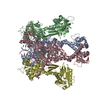+Search query
-Structure paper
| Title | Discovery of isoquinoline sulfonamides as allosteric gyrase inhibitors with activity against fluoroquinolone-resistant bacteria. |
|---|---|
| Journal, issue, pages | Nat Chem, Year 2024 |
| Publish date | Jun 19, 2024 |
 Authors Authors | Alexander T Bakker / Ioli Kotsogianni / Mariana Avalos / Jeroen M Punt / Bing Liu / Diana Piermarini / Berend Gagestein / Cornelis J Slingerland / Le Zhang / Joost J Willemse / Leela B Ghimire / Richard J H B N van den Berg / Antonius P A Janssen / Tom H M Ottenhoff / Constant A A van Boeckel / Gilles P van Wezel / Dmitry Ghilarov / Nathaniel I Martin / Mario van der Stelt /   |
| PubMed Abstract | Bacteria have evolved resistance to nearly all known antibacterials, emphasizing the need to identify antibiotics that operate via novel mechanisms. Here we report a class of allosteric inhibitors of ...Bacteria have evolved resistance to nearly all known antibacterials, emphasizing the need to identify antibiotics that operate via novel mechanisms. Here we report a class of allosteric inhibitors of DNA gyrase with antibacterial activity against fluoroquinolone-resistant clinical isolates of Escherichia coli. Screening of a small-molecule library revealed an initial isoquinoline sulfonamide hit, which was optimized via medicinal chemistry efforts to afford the more potent antibacterial LEI-800. Target identification studies, including whole-genome sequencing of in vitro selected mutants with resistance to isoquinoline sulfonamides, unanimously pointed to the DNA gyrase complex, an essential bacterial topoisomerase and an established antibacterial target. Using single-particle cryogenic electron microscopy, we determined the structure of the gyrase-LEI-800-DNA complex. The compound occupies an allosteric, hydrophobic pocket in the GyrA subunit and has a mode of action that is distinct from the clinically used fluoroquinolones or any other gyrase inhibitor reported to date. LEI-800 provides a chemotype suitable for development to counter the increasingly widespread bacterial resistance to fluoroquinolones. |
 External links External links |  Nat Chem / Nat Chem /  PubMed:38898213 PubMed:38898213 |
| Methods | EM (single particle) |
| Resolution | 2.9 Å |
| Structure data | EMDB-18592, PDB-8qqi: |
| Chemicals | 
ChemComp-LRL:  ChemComp-MG: |
| Source |
|
 Keywords Keywords | DNA BINDING PROTEIN / TOPOISOMERASE / GYRASE / ALLOSTERIC INHIBITOR / ANTIBIOTIC |
 Movie
Movie Controller
Controller Structure viewers
Structure viewers About Yorodumi Papers
About Yorodumi Papers






 escherichia phage mu (virus)
escherichia phage mu (virus)